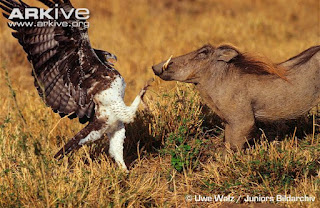Anyways, back to birds. Today I'll write about raptors. Birds tend to freak me out a little, because of their tendency to poop unannounced and I feel like they are really dirty. But if I had to choose birds that I actually liked, I'd have to go with raptors. So today's blog entry is about raptors. The first raptor of the evening is the Bateleur. It is a medium-sized eagle in the same family as buzzards, kites, and harriers. It has a very distinct short tail which makes it unmistakable in flight. An adult male is 24-30 inches in length with nearly a 6 foot wingspan, and weighs around 4-6 pounds. It hunts a territory of 250 square miles a day, preying upon birds and small mammals. "Bateleur" is French for "tight-rope walker", and describes the bird's tendency to tip the ends of its wings when flying, as if catching its balance. This bird can be found in Kruger National Park.
 |
| The Bateleur has a distinctive short tail |
 |
| The Bateleur is sometimes called the Pine Eagle because its feathers resemble a conifer cone when puffed out |
Next on the list is the Bat Hawk, which is named for its bat-based diet. It is another medium-sized raptor, being a typical length of 18 inches. Besides bats, they also eat small birds and even insects. It is a crepuscular bird, meaning it is most active at twilight. The bat hawk can be seen at Kruger National Park.
The African Fish Eagle is a large species of eagle that resembles the Bald Eagle in appearance. The female bird is larger than the male, weighing in at 7-8 pounds and having a wingspan of up to 8 feet. The male, on the other hand, weighs only 4-5 pounds and has a wingspan of up to 6 feet. Apparently, this is typical sexual dimorphism in birds of prey. As its name suggests, it preys mostly upon fish, but it is opportunistic and will take a wider variety of prey when the opportunity presents itself. It has special structures on its toes called spiricules that allow it to grasp fish and other slippery prey items. If it happens to catch a fish that is over four pounds, it will be too heavy for the eagle to lift, so it will drag the fish across the water until it reaches the shore. It has a distinctive cry that is often cited to be evocative of the spirit of Africa. They are believed to be monogamous, meaning that they mate for life. I should be able to spot them in Kruger National Park.
Last, but certainly not least, is the Martial Eagle. It is a very large eagle, with a length of up to 38 inches, a weight of up to 13 pounds, and a wingspan of up to 7.45 feet. It is the largest eagle in Africa. It is also one of the world's most powerful avian predators. It eats birds, reptiles (including puff adders and black mambas), and mammals. It can prey upon mammals as big as young warthogs and impala lambs. It is abundant in protected areas such as Kruger National Park, but elsewhere it faces serious decline due to shooting, poisoning, and man-made obstacles such as powerlines.
CHEETAH TIME!!!
Cheetah cubs can fall victim to the larger raptors.








No comments:
Post a Comment